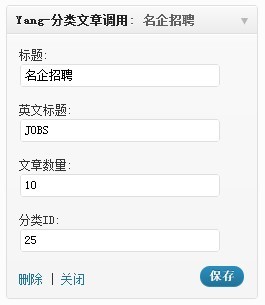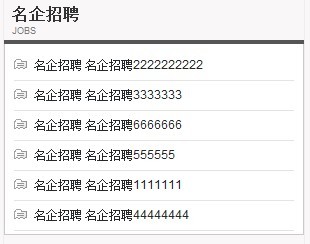
- 十月站长观察:空杯心态让草根走得更远
- 聊聊HTTPS和SSL/TLS协议
- 爆款弱化后淘宝之路该如何走
- HTML语言标准优化浅谈链接和协议规则
- 做好三个方面轻松应对网站挂码问题
- IDG曹迪军:风投看重团队背景 关键在商业模式
- 和用户互动共享 提升网站对用户的“粘性”
- UPA2008讲稿:互联网产品的交互设计方法
- 站长乐事:访问量从1千到6万 全是意外
- 让Google教你学习搜索引擎优化
- 同性恋主题网站的建站经历
- 为什么说上网看这些学运营的文章并没有什么卵用?
- 手工打造干净精简的Debian VPS系统
- 互联网突破之站长必备三个要素:行业性 专注性 可行性
- 做为SEOer你每天应该记录分析哪些数据
- 浅谈平面设计师转型网店美工的必备技能
- 王大君:zblog博客备份指南
- 对网站刷百度搜索点击一些个人看法
- 站长要学习曾轶可的精神
- 站一排论道:如果我有钱,我就不做站长了
- WordPress商业主题禁用谷歌字体的解决方案
- 用好织梦站内搜索 提高用户体验
- 站长总结:快速增加新浪微博粉丝心得
- 使用Easy2PHP搭建Bo-Blog本地调试
- 做好网站测试工作的四项标准内容
- 芭奇:不用编写采集规则也可轻松采集网站
- 刘经赟:百度开放平台下SEM新模式
- 案例:网站价值不再用流量衡量才算成功
- 谷歌为“OptimizeGoogle.com”域名申请域名仲裁
- ASP.NET的优化:黑帽seo Html注入和Nofollow
WordPress自定义侧边栏小工具
wordpress主题小工具,可以自由拖动到侧边栏,并在前台实现相应功能!但主题自带的小工具一般不能满足我们更强大的需求,怎样,跟着看看怎么自定义侧边栏小工具!
我们先来了解一些个概念性的东西,不想了解可直接跳过,无妨对后面的小工具制作的理解!wordpress提供了一个WP_Widget类,我们只需要扩展WP_Widget类,就可以制作自己的小工具(widget),此类文件位于 wp-includes\widgets.php,无聊的可以扒来看看!
下面结合实例来说一下小工具的制作流程,实例小工具的功能是实现调用指定分类的文章!下面正式开始:
新建一个文件 cat_posts.php,并在主题 Functions.php 里引入此文件!cat_posts.php 主要包含以下几个部分:
1、自定义扩展类
首先定义一个 WP_Widget 的扩展类,类名随意但不得与其它类名冲突,比如 catPostsWidget,同时构造函数。
class catPostsWidget extends WP_Widget {
/*
** 声明一个数组$widget_ops,用来保存类名和描述,以便在主题控制面板正确显示小工具信息
** $control_ops 是可选参数,用来定义小工具在控制面板显示的宽度和高度
** 最后是关键的一步,调用WP_Widget来初始化我们的小工具
**/
function catPostsWidget(){
$widget_ops = array('classname'=>'widget_random_posts','description'=>'随机显示你博客中的文章');
$control_ops = array('width'=>250,'height'=>300);
$this->WP_Widget(false, '分类文章调用', $widget_ops, $control_ops);
}
}
注:构造函数 catPostsWidget() 中定义了两个数组变量$widget_ops和$control_pos,传递给$this->WP_Widget()进行小工具的初始化。
WP_Widget参数详解:
第一个参数是$id_base,我们一般设置成false即可,也可以使用小工具的名字,如 ‘catPostsWidget’;
第二个参数指定小工具显示的名称;
第三个参数指定类名和小工具的描述,这两个参数结合在一起的效果如下
第四个参数定义小工具的宽度和高度,一般只需要前三个参数即可,它影响的效果是当你把小工具拖到侧边栏时的宽度和高度。
2、扩展类的三个重要函数
小工具扩展类需要定义的三个重要函数:form()、update()、widget()
form()函数一般是用来显示小工具的选项设置表单,表单的内容根据需要自己定义,示例小工具定义了4个选项可供设置:
title:模块标题,可设默认值,如“分类文章”;
title_en:英文标题,可设默认值,如“Title”;
num:显示文章数量,可设默认值,如 10;
cat:分类目录ID,,可设默认值,如0,即显示所有分类下的文章
后台显示效果:

form() 函数代码:
function form($instance){
//title:模块标题,title_en:英文标题,showPosts:显示文章数量,cat:分类目录ID
$instance = wp_parse_args((array)$instance,array('title'=>'分类文章','title_en'=>'Title','showPosts'=>10,'cat'=>0));//默认值
$title = htmlspecialchars($instance['title']);
$title_en = htmlspecialchars($instance['title_en']);
$showPosts = htmlspecialchars($instance['showPosts']);
$cat = htmlspecialchars($instance['cat']);
echo '<p style="text-align:left;"><label for="'.$this->get_field_name('title').'">标题:<input style="width:200px;" id="'.$this->get_field_id('title').'" name="'.$this->get_field_name('title').'" type="text" value="'.$title.'" /></label></p>';
echo '<p style="text-align:left;"><label for="'.$this->get_field_name('title_en').'">英文标题:<input style="width:200px;" id="'.$this->get_field_id('title_en').'" name="'.$this->get_field_name('title_en').'" type="text" value="'.$title_en.'" /></label></p>';
echo '<p style="text-align:left;"><label for="'.$this->get_field_name('showPosts').'">文章数量:<input style="width:200px;" id="'.$this->get_field_id('showPosts').'" name="'.$this->get_field_name('showPosts').'" type="text" value="'.$showPosts.'" /></label></p>';
echo '<p style="text-align:left;"><label for="'.$this->get_field_name('cat').'">分类ID:<input style="width:200px" id="'.$this->get_field_id('cat').'" name="'.$this->get_field_name('cat').'" type="text" value="'.$cat.'" /></label></p>';
}
设置表单中$instance数组的4个key:title、title_en、showPosts、cat(key名可自由定义),然后由 wordpress 的函数 get_field_name 和 get_field_id 将表单中的设置项都保存到相应的数组Key中。
update()函数用于更新保存由 form() 表单传递来的设置项数据。
function update($new_instance,$old_instance){
$instance = $old_instance;
$instance['title'] = strip_tags(stripslashes($new_instance['title']));
$instance['title_en'] = strip_tags(stripslashes($new_instance['title_en']));
$instance['showPosts'] = strip_tags(stripslashes($new_instance['showPosts']));
$instance['cat'] = strip_tags(stripslashes($new_instance['cat']));
return $instance;
}
注:此函数也可省略不定义,默认返回的将是 $new_instance,也就是说在小工具选项中所做的更改同样能得到保存,但为了保证表单中数据的安全性,我们可以定义一下,并可使用php函数 strip_tags 和 stripslashes 来过滤掉输入的不合法的字符。
widget() 函数定义小工具在前台页面中的显示样式
function widget($args, $instance){
extract($args);
$title = apply_filters('widget_title', empty($instance['title']) ? __('分类文章Title','yang') : $instance['title']);//小工具前台标题
$title = $title . ''.$instance['title_en'].'';
$showPosts = empty($instance['showPosts']) ? 10 : $instance['showPosts'];
$cat = empty($instance['cat']) ? 0 : $instance['cat']; echo $before_widget;
if( $title ) echo $before_title . $title . $after_title; $query = new WP_Query("cat=$cat&showposts=$showPosts&orderby=rand");
if($query->have_posts()){
echo '<ul>';
while($query->have_posts()){
$query->the_post();
echo '<li><a href="'.get_permalink().'">'.get_the_title().'</a></li>';
}
echo '</ul>';
} echo $after_widget;
}
先使用了extract函数把数组中的keys转换成变量,然后从$instance中取出保存的各个key的值,再输出一下文章列表样式即可。
前端效果图如下:

注册小工具
到此,自定义小工具类 catPostsWidget 已经定义完成,最后我们还需要一步:注册小工具类,以完成对小工具的激活。
register_widget('catPostsWidget');
注:激活代码要放在类定义之外。
好了,如此完整,你还不赶紧自定义一个!!
文章来源:http://www.nuodou.com/a/856.html
- 上一篇文章: 暑期做站长:建站方向与程序推荐
- 下一篇文章: 如何创建WordPress数据库备份?